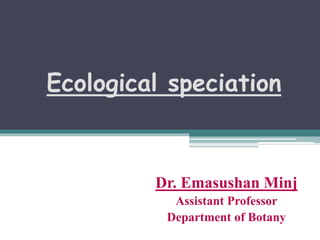
Ecological Speciation: How Divergent Selection Leads to Reproductive Isolation
- 1. Ecological speciation Dr. Emasushan Minj Assistant Professor Department of Botany
- 2. Introduction • Ecological speciation is the process by which ecologically based divergent selection between different environments leads to the creation of reproductive barriers between populations. • Natural selection is inherently involved in the process of speciation- "under ecological speciation, populations in different environments, or populations exploiting different resources, experience contrasting natural selection pressures on the traits that directly or indirectly bring about the evolution of reproductive isolation". • Evidence for the role ecology plays in the process of speciation exists. • Studies of populations bear ecologically-linked speciation arising as a by-product, along numerous studies of parallel speciation which proves speciation's occurrence in nature.
- 3. • The key difference between ecological speciation and other kinds of speciation is that it is triggered by divergent natural selection among different habitats- as opposed to other kinds of speciation processes, like random genetic drift, the fixation of incompatible mutations in populations experiencing similar selective pressures, or various forms of sexual selection not involving selection on ecologically relevant traits. • Ecological speciation can occur either in allopatry, sympatry, or parapatry.
- 4. Parallel speciation • It is where "greater reproductive isolation repeatedly evolves between independent populations adapting to contrasting environments than between independent populations adapting to similar environments". • It is a special form of parallel evolution in which traits that determine reproductive isolation evolve repeatedly in independent, closely related populations as a by-product of adaptation to different environments.
- 5. Types of Speciation • Speciation is the method of formation of new species. A species can be defined as one or more populations of interbreeding organisms that are reproductively isolated in nature from all other organisms. As natural selection adapts populations occupying different environments, they will diverge into races, subspecies, and finally separate species. When populations no longer interbreed, they are thought to be separate species. ▫ Type 1. Allopatric Speciation ▫ Type 2. Sympatric Speciation
- 6. Type 1. Allopatric Speciation: • Allopatric speciation is the evolution of species in a population that occupy different geographical areas. • Geographic isolation is often the first step in allopatric speciation. • Other isolating mechanism may also operate that further restrict reproduction between populations. • An example of allopatric speciation is the Darwin’s finches. • The finches varied from each other mainly in shape and size of beak and color of the feathers or plumage. • According to Darwin, the species in the South American mainland were the original species from which different forms migrated to different islands of the Galapagos and became adapted to the environmental conditions of these islands. The adapted forms eventually became the new species. • In the case of the finches, geographical isolation led to the development of reproductive isolation and thereby to the origin of new species.
- 8. Type 2. Sympatric Speciation: • Speciation within a population that occupies the same geographic environment by either ecological isolation (differing habitats) or by chromosomal aberrations as seen in plants is known as sympatric speciation. • Sympatric speciation happens when members of a population develop genetic differences that prevent them from reproducing with the parent type.
- 9. Thank you